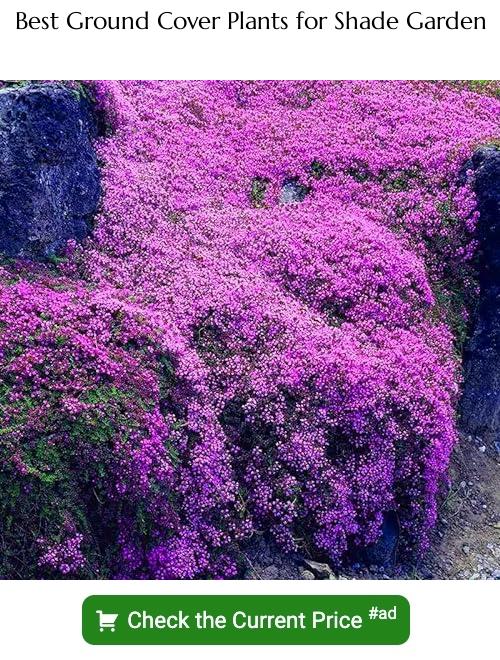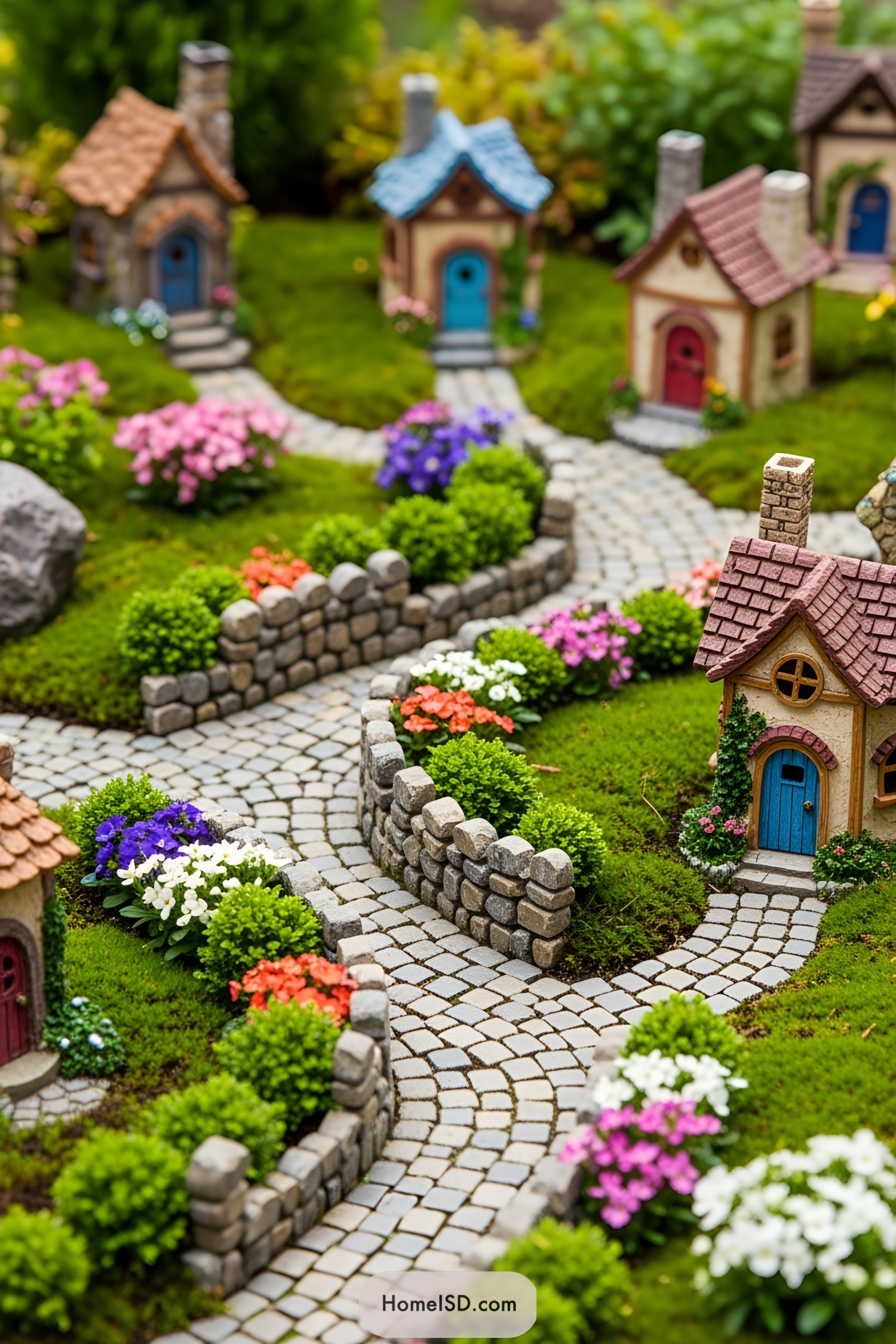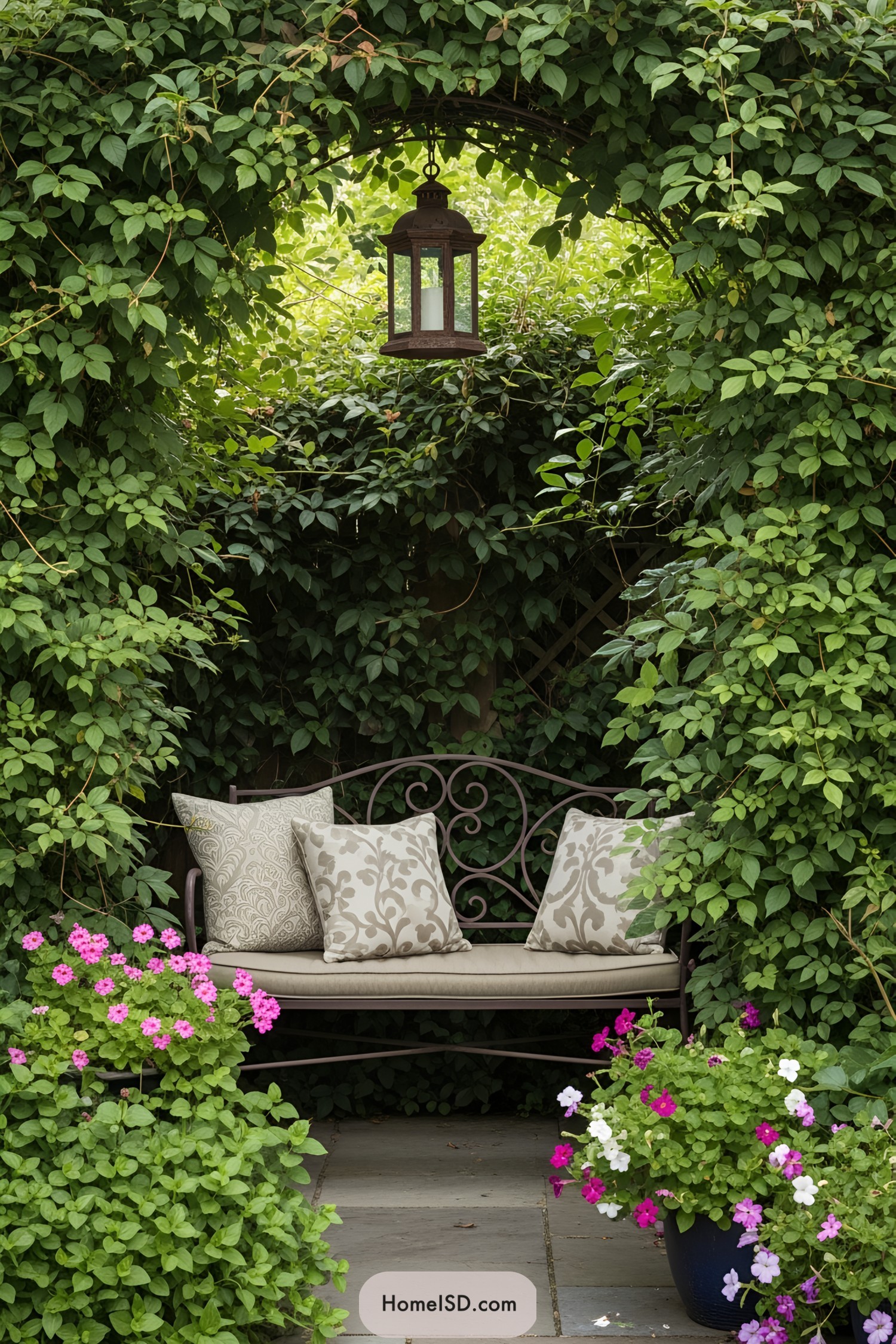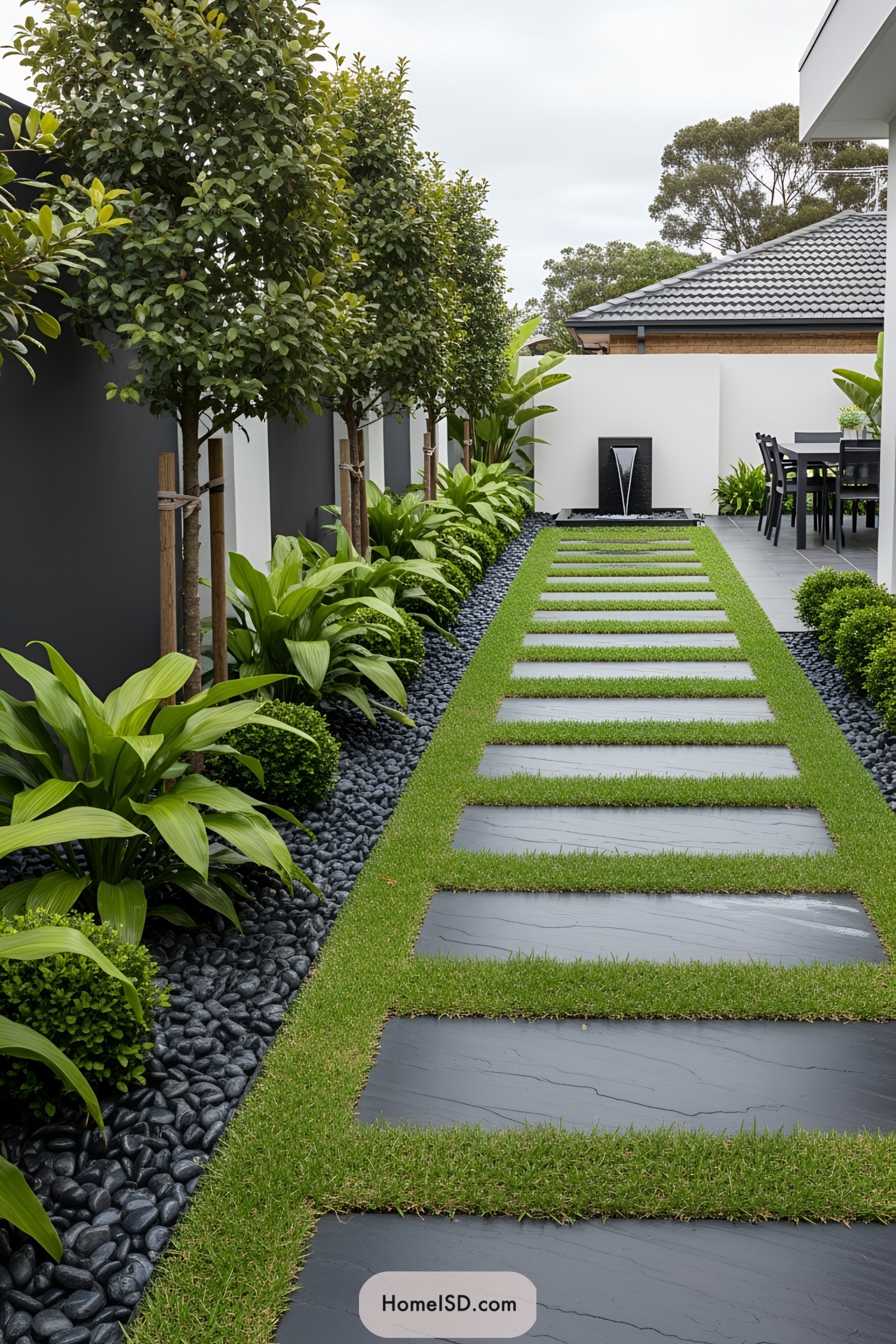Last updated on
Discover a variety of attractive and low-maintenance alternatives to pachysandra for your garden in this informative blog post.
Are you tired of the same old landscaping plants in your yard? Look no further than pachysandra alternatives! Pachysandra is a popular ground cover plant, but it can be overused and sometimes difficult to maintain. Luckily, there are plenty of other options out there that can add unique texture and color to your outdoor space without breaking the bank.
In this article, we’ll explore some of the best pachysandra alternatives that will make your yard stand out from the rest. Get ready to transform your landscape with these budget-friendly options!
Understanding Ground Covers
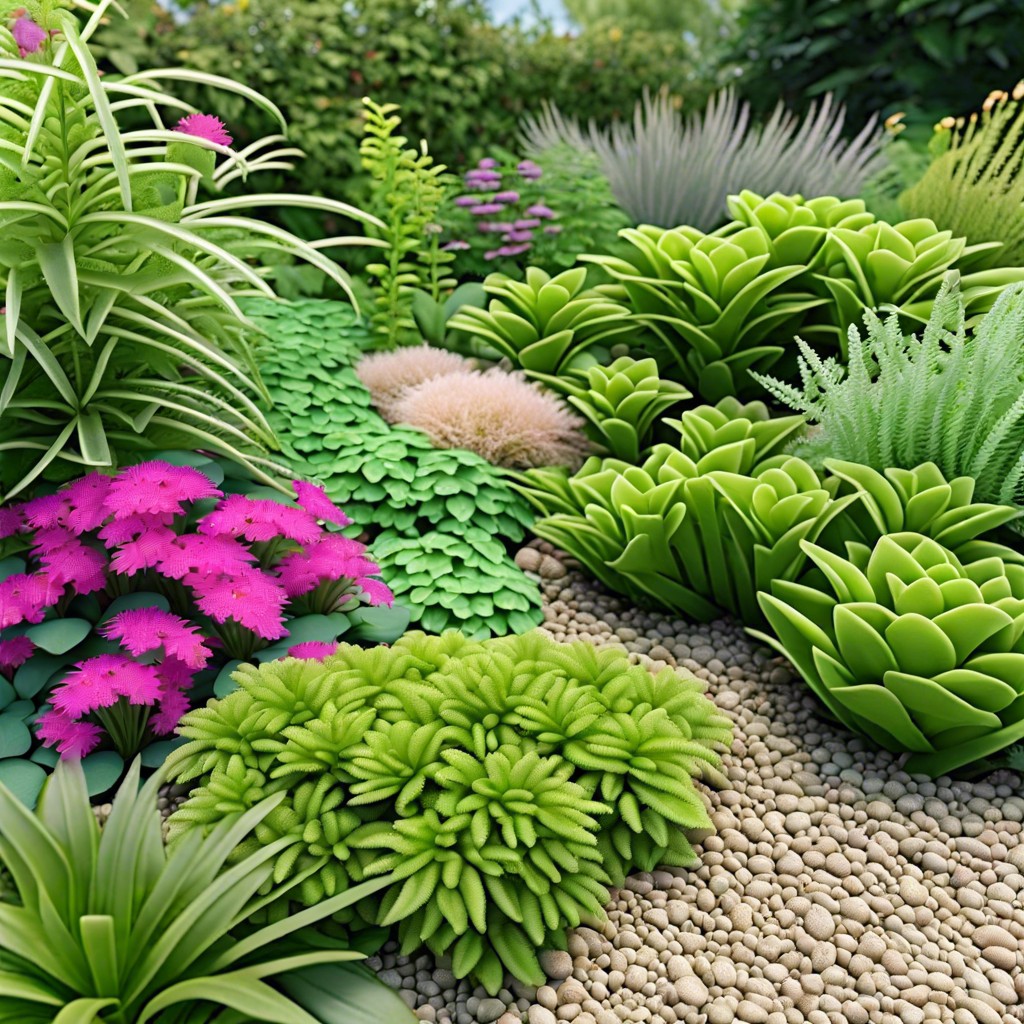
Understanding the different types of ground covers available can help you choose the best options for your yard. Some ground cover plants, like pachysandra, spread quickly and require little maintenance once established.
Others may need more attention but offer unique textures or colors that make them stand out.
When selecting a ground cover plant, consider factors such as soil type, sun exposure levels in your yard, and water requirements. Some plants thrive in shady areas while others prefer full sun exposure; some do well in dry soils while others require moist conditions.
It’s important to note that not all ground covers are created equal when it comes to environmental impact. Invasive species can take over natural habitats if they escape cultivation or aren’t properly maintained by homeowners.
Native Pachysandra Alternatives
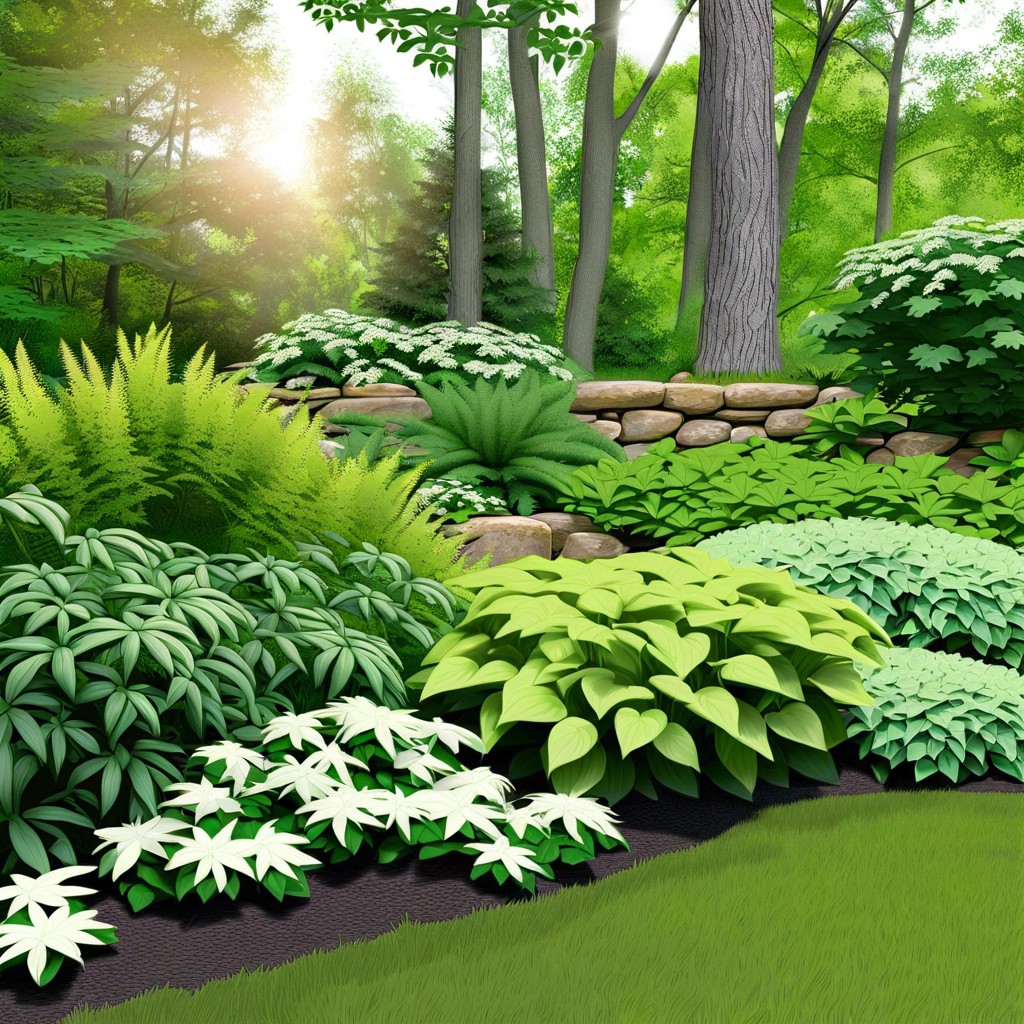
Native plants are often easier to maintain and better suited to the local climate, making them an excellent choice for any garden. Some popular native pachysandra alternatives include creeping phlox (Phlox subulata), wild ginger (Asarum canadense), and foamflower (Tiarella cordifolia).
These plants not only add beauty but also provide important ecological benefits such as attracting pollinators and supporting local wildlife.
When selecting a native alternative, it’s essential to consider the plant’s growing requirements carefully. For example, some species may prefer full sun while others thrive in shade or partial shade conditions.
Soil type and moisture levels should be taken into account when choosing which plant will work best in your landscape.
Creeping Thyme
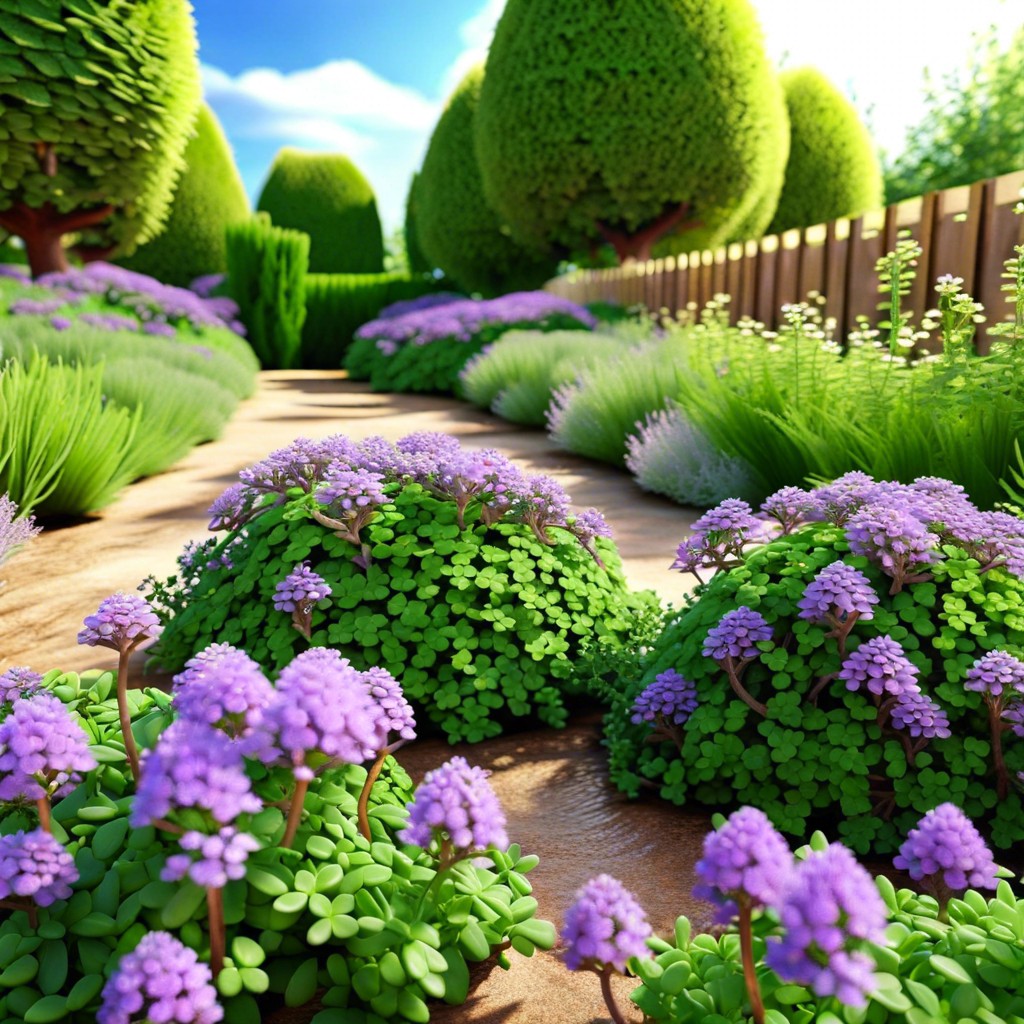
This low-growing herbaceous plant produces fragrant leaves and small pink or purple flowers in the summer, making it an excellent choice for ground cover. Creeping thyme is also drought-tolerant, which means you won’t have to worry about watering it as frequently as other plants.
One of the best things about creeping thyme is its versatility. It can be used in a variety of ways, from filling gaps between stepping stones to covering large areas of your yard.
Plus, because it’s so easy to grow and maintain, even novice gardeners can enjoy its benefits.
To get started with creeping thyme in your own yard, simply choose a sunny spot with well-draining soil and plant the seeds or seedlings according to package instructions. Once established, this hardy ground cover will provide years of beauty without requiring much attention from you.
Sweet Woodruff
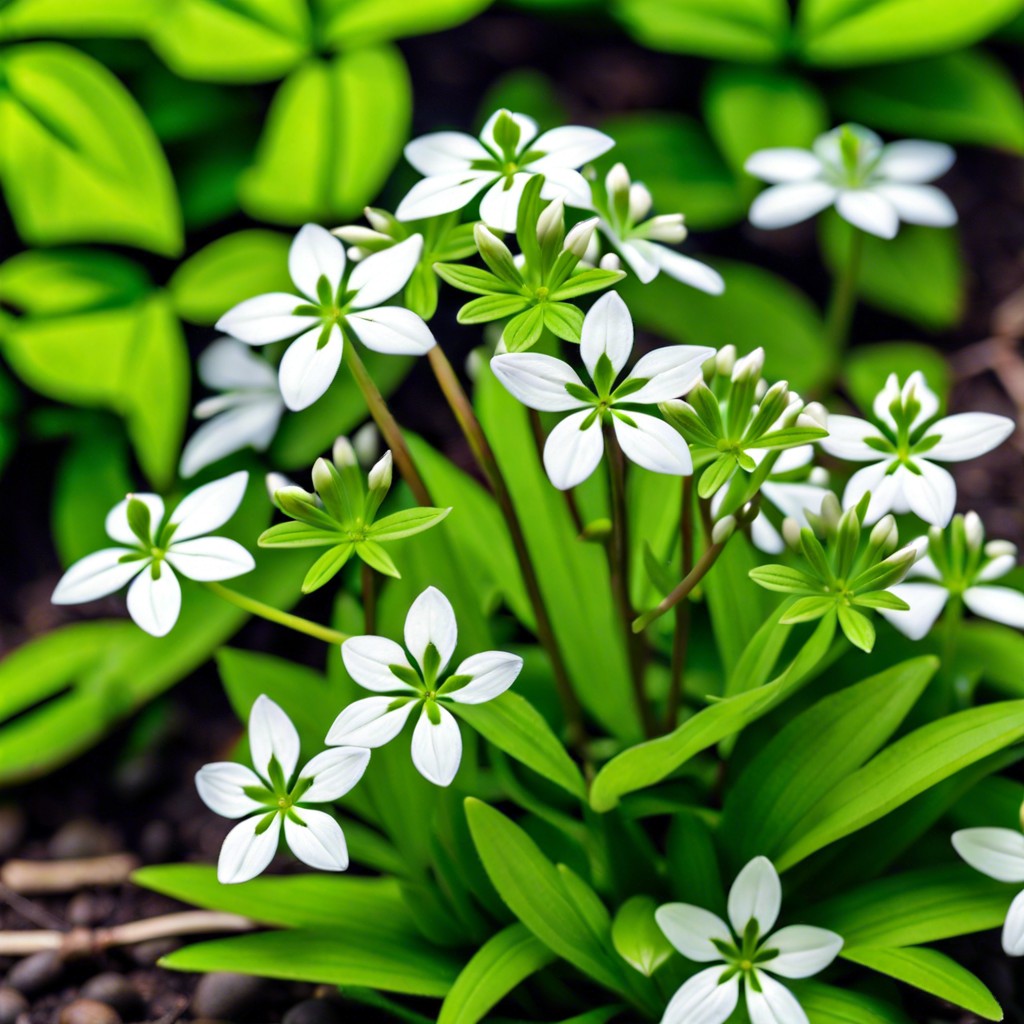
This low-growing perennial plant features delicate white flowers and bright green leaves with an attractive star shape. Sweet woodruff thrives in shady areas, making it perfect for under trees or along the edges of your yard where other plants may struggle.
One of the best things about sweet woodruff is its versatility. It can be used as both a ground cover and an accent plant, depending on how you choose to incorporate it into your landscape design.
Its fragrant aroma also makes it ideal for use in potpourri or as a natural air freshener.
When planting sweet woodruff, make sure to give each plant enough space to grow without crowding out neighboring plants. It prefers moist soil but can tolerate some dryness once established.
Ajuga Reptans
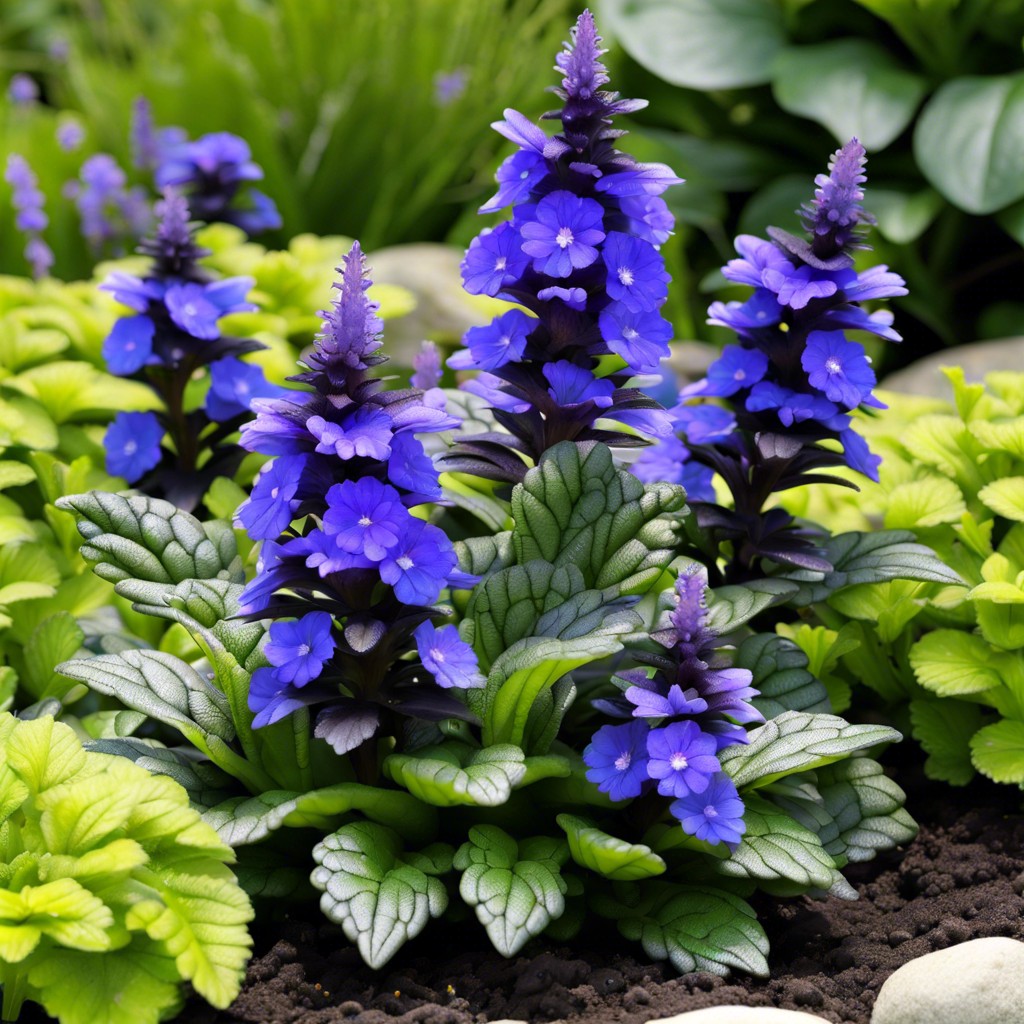
This low-growing perennial has glossy green leaves and produces spikes of blue or purple flowers in the spring. Ajuga reptans thrives in partial shade and moist soil conditions but can tolerate some sun exposure.
One of the benefits of using ajuga reptans as a ground cover is its ability to spread quickly and form dense mats that suppress weed growth. It’s also relatively easy to maintain since it doesn’t require frequent watering or fertilization.
When planting ajuga reptans, make sure to space them about 6-12 inches apart so they have room to grow and fill out over time. They prefer well-draining soil with plenty of organic matter mixed in for optimal growth.
Phlox Subulata
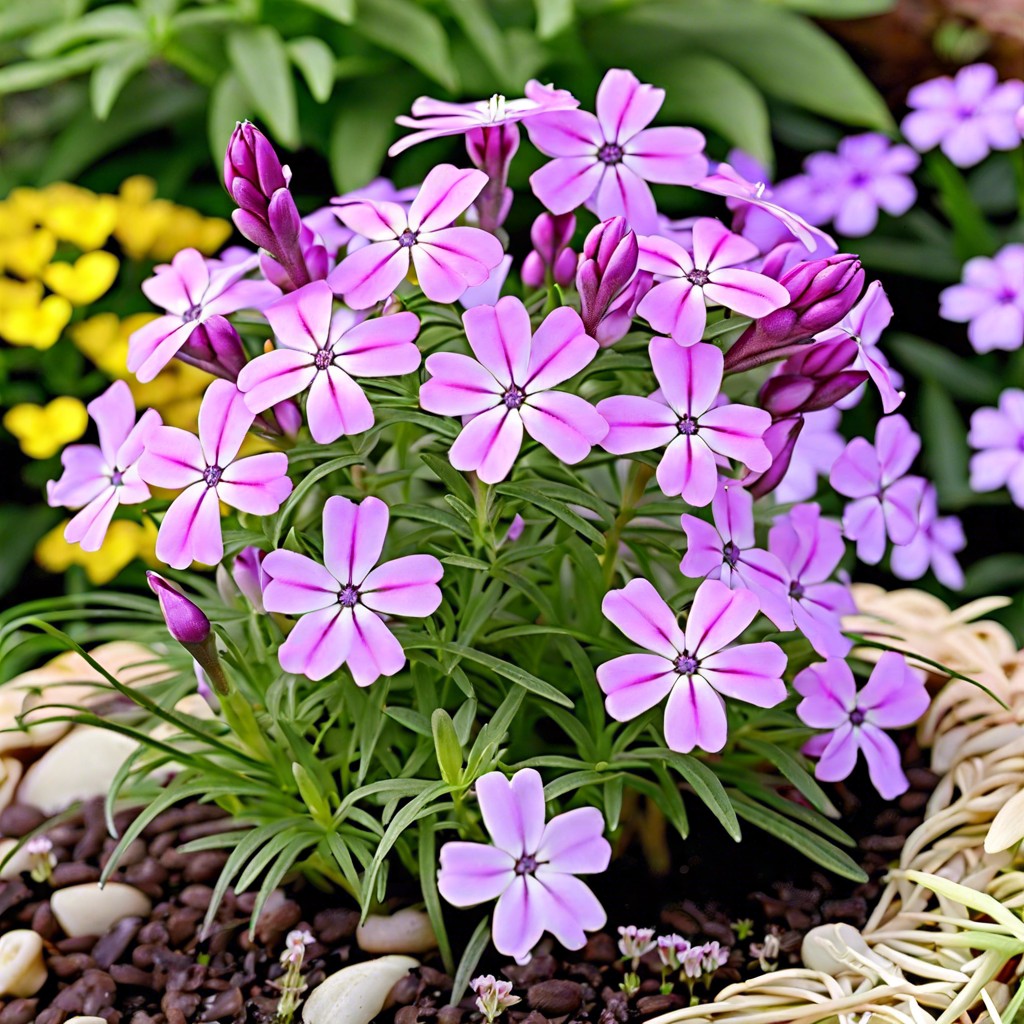
This low-growing perennial produces masses of small flowers in shades of pink, purple and white from early spring through late summer. It’s perfect for rock gardens or along the edges of garden beds where it can spill over onto walkways.
One advantage of using phlox subulata instead of pachysandra is its ability to thrive in full sun. While pachysandra prefers shade and may struggle in direct sunlight, phlox subulata actually requires at least six hours per day to produce its vibrant blooms.
Another benefit is that this plant requires very little maintenance once established. It’s drought-tolerant and doesn’t require frequent watering like some other ground covers do.
Vinca Minor
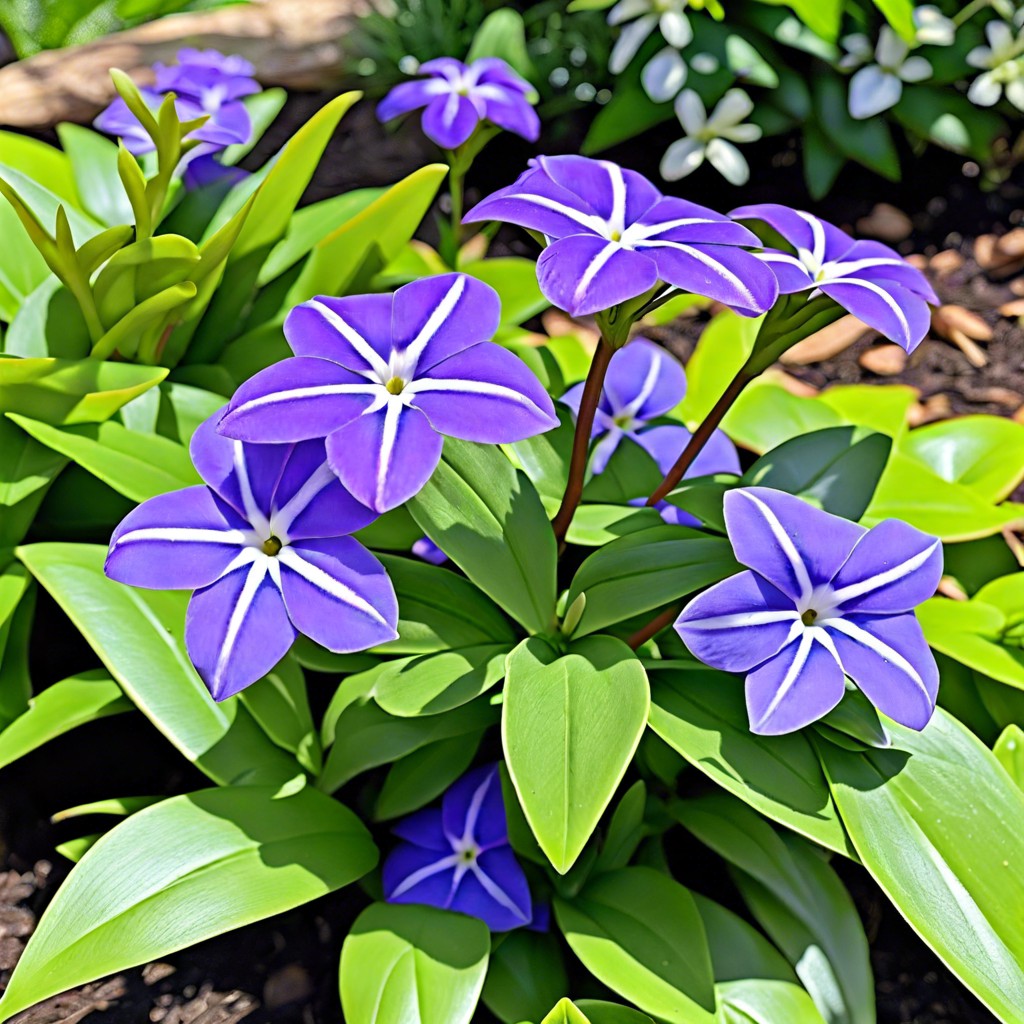
This evergreen perennial produces glossy green leaves and delicate blue-purple flowers in the spring. Vinca minor is low-maintenance and easy to grow, making it a great choice for gardeners who want attractive landscaping without spending too much time on upkeep.
One of the benefits of vinca minor is its ability to thrive in both sun and shade. It prefers moist soil but can tolerate drought once established.
This makes it a versatile option for different areas of your yard.
When planting vinca minor, make sure you space them about 12 inches apart so they have room to spread out over time. They will quickly fill in any bare spots with their trailing stems that root along the way.
To keep your vinca looking healthy and lush throughout the year, prune back any dead or damaged foliage regularly during growing season (spring through fall). You may also need to trim back some runners if they start encroaching on other plants nearby.
Irish Moss

This low-growing ground cover plant has small, delicate leaves that form a dense mat of greenery. It’s perfect for filling in gaps between stepping stones or as an accent around larger plants.
One of the benefits of Irish Moss is its ability to thrive in both sun and shade, making it versatile for any landscape design. It also requires minimal maintenance once established, making it an ideal choice for those who want beautiful landscaping without the hassle.
To get started with Irish Moss, choose a well-draining soil location with partial shade or full sun exposure depending on your preference. Plant them about 6 inches apart from each other so they have room to spread out over time.
Creeping Jenny
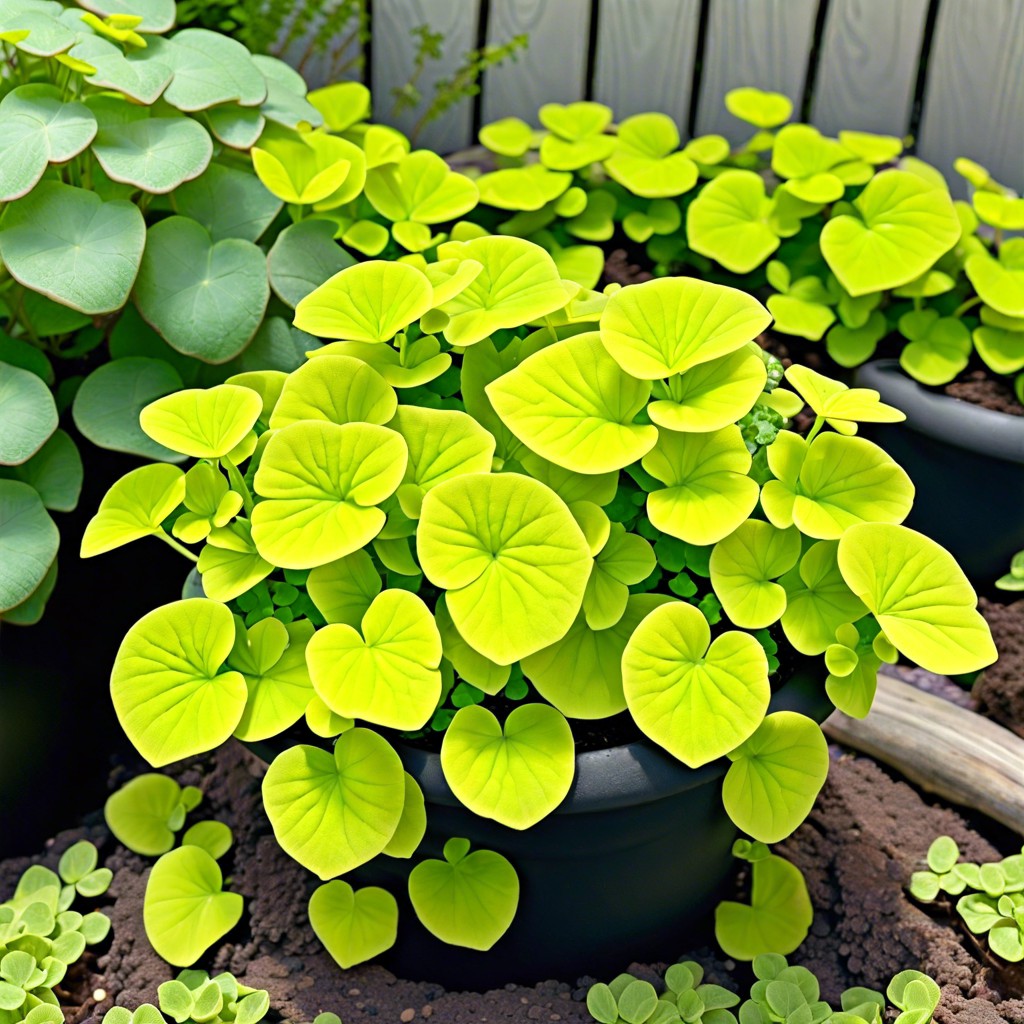
This plant thrives in moist soil and partial shade but can tolerate full sun with adequate watering. Creeping Jenny spreads quickly and easily by rooting at the nodes along its stems, making it an excellent choice for filling in gaps between other plants or covering large areas.
One of the benefits of using Creeping Jenny as an alternative to Pachysandra is its versatility. It works well in rock gardens, borders or even hanging baskets due to its trailing habit.
The small yellow flowers that bloom on this plant during summer are another added bonus.
When planting Creeping Jenny, make sure you give it enough space to spread out without overcrowding other plants nearby. It’s important not to let this ground cover dry out completely; regular watering will help keep it healthy and vibrant throughout the growing season.
Lamb’s Ear

This plant gets its name from the soft, fuzzy leaves that resemble the ears of a lamb. Lamb’s Ear is easy to grow, drought-tolerant, and low-maintenance – making it an excellent alternative to pachysandra.
This plant thrives in full sun or partial shade and prefers well-draining soil. It grows quickly but doesn’t spread aggressively like some other ground covers do.
Lamb’s Ear produces small purple flowers on tall spikes in late spring or early summer which attract pollinators such as bees.
One of the benefits of using Lamb’s Ear as a ground cover is its versatility; it can be used for edging pathways or planted en masse for larger areas. Its silvery-green foliage also provides an interesting contrast when paired with darker plants.
To maintain this plant, simply trim back any dead foliage in early spring before new growth appears.
Heuchera
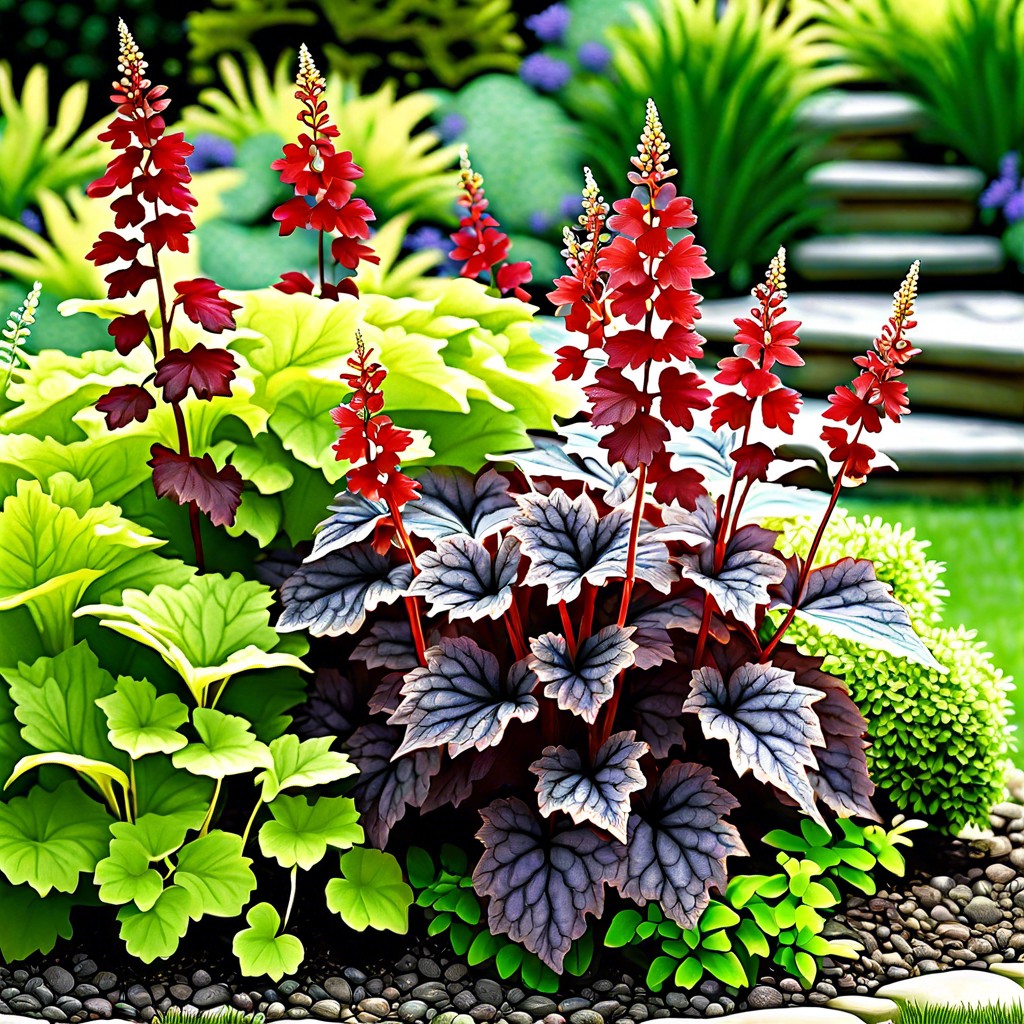
These plants come in a variety of shades ranging from deep burgundy to bright lime green and everything in between. Heuchera thrives in partial shade and well-drained soil making it an excellent choice for those hard-to-fill areas under trees or along walkways.
One of the benefits of heuchera is its versatility; it can be used as both a ground cover plant or as an accent piece within your existing landscaping design. Its unique foliage provides texture and interest even when not blooming, but when the delicate flowers do appear they add another layer of beauty to your outdoor space.
When planting heuchera, make sure you choose a location with good drainage and amend the soil with compost if necessary. Water regularly during dry spells but avoid overwatering which can lead to root rot.
Heuchera is an excellent option for those looking for low-maintenance yet visually stunning alternatives to pachysandra.
Ferns As Alternatives
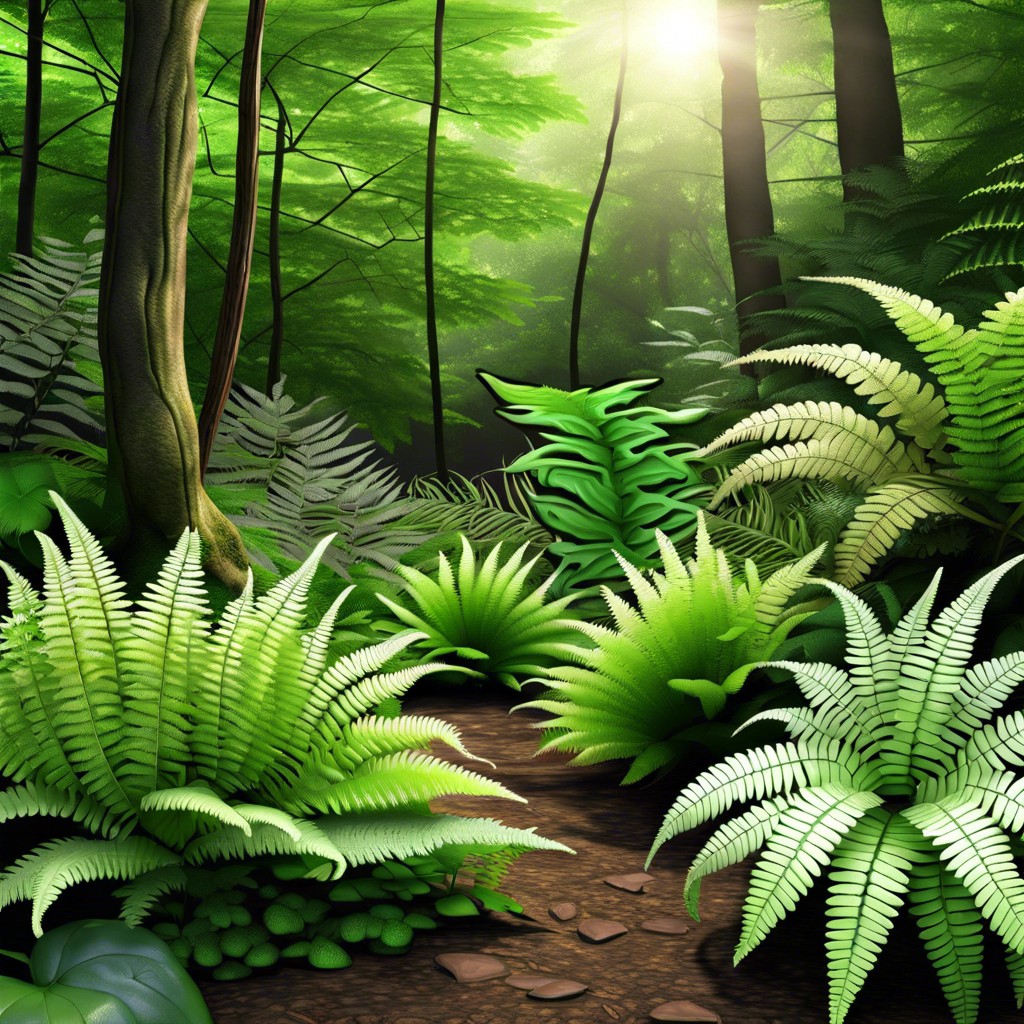
They come in many different varieties and can thrive in both sun and shade. Some popular fern options include maidenhair ferns, ostrich ferns, and Japanese painted ferns.
One benefit of using ferns as ground cover is that they require very little maintenance once established. They also provide excellent erosion control on slopes or hillsides due to their extensive root systems.
When planting your new ground cover with Fern species, it’s important to choose the right location based on sunlight requirements and soil type preferences. Most prefer moist soil conditions but there are some that can tolerate drier soils too.
Sedum Species
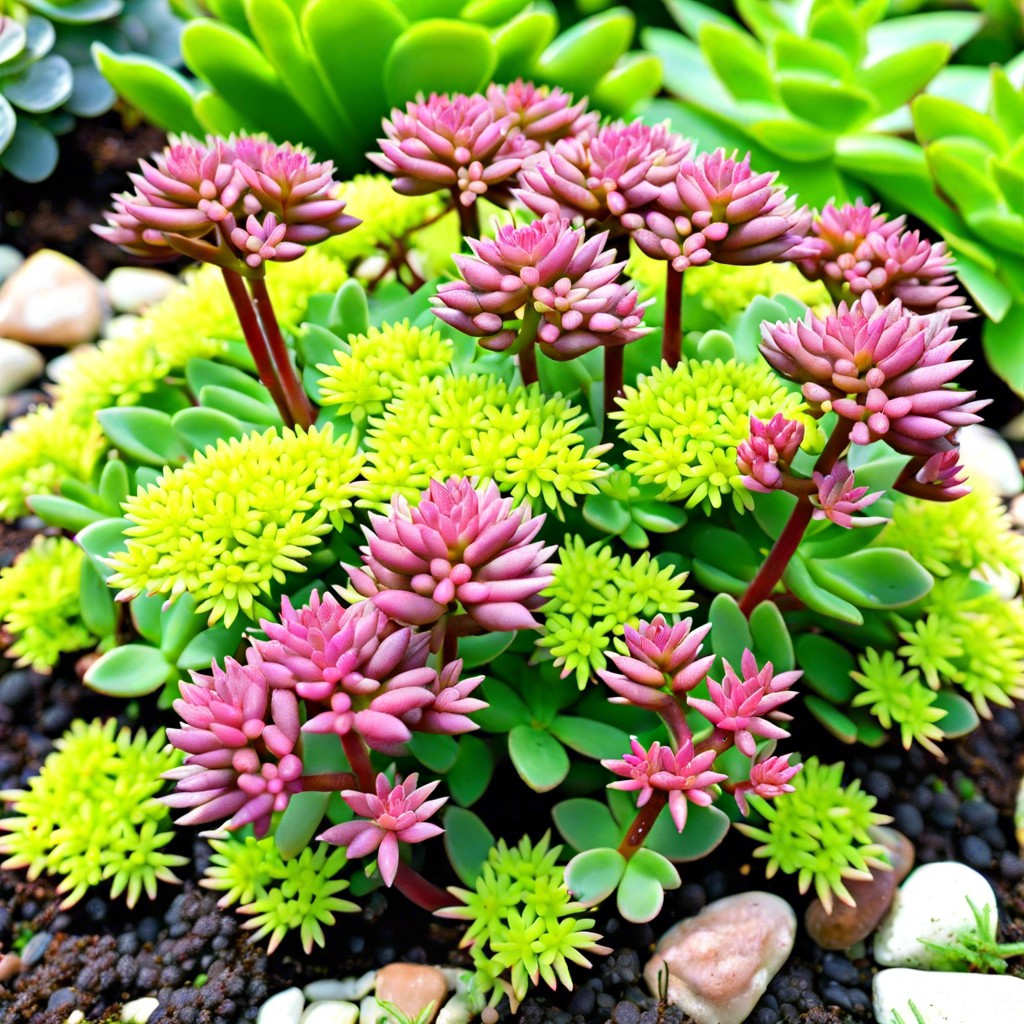
These plants come in a variety of colors and textures, from the classic green sedum to varieties with red or purple foliage. Sedums also produce beautiful flowers in late summer or early fall, adding even more interest to your garden.
One popular sedum species is Sedum spurium ‘Dragon’s Blood’, which has deep red leaves that turn bronze in the winter months. Another option is Sedum acre ‘Aurea’, which features bright yellow-green foliage and small yellow flowers.
When planting sedums as ground cover, it’s important to choose a well-draining soil mix and provide plenty of sunlight. Once established, these plants require very little maintenance beyond occasional watering during dry spells.
In addition to their beauty and low-maintenance nature, sedums are also beneficial for pollinators like bees and butterflies who rely on their nectar-rich blooms as a food source.
Houttuynia Cordata
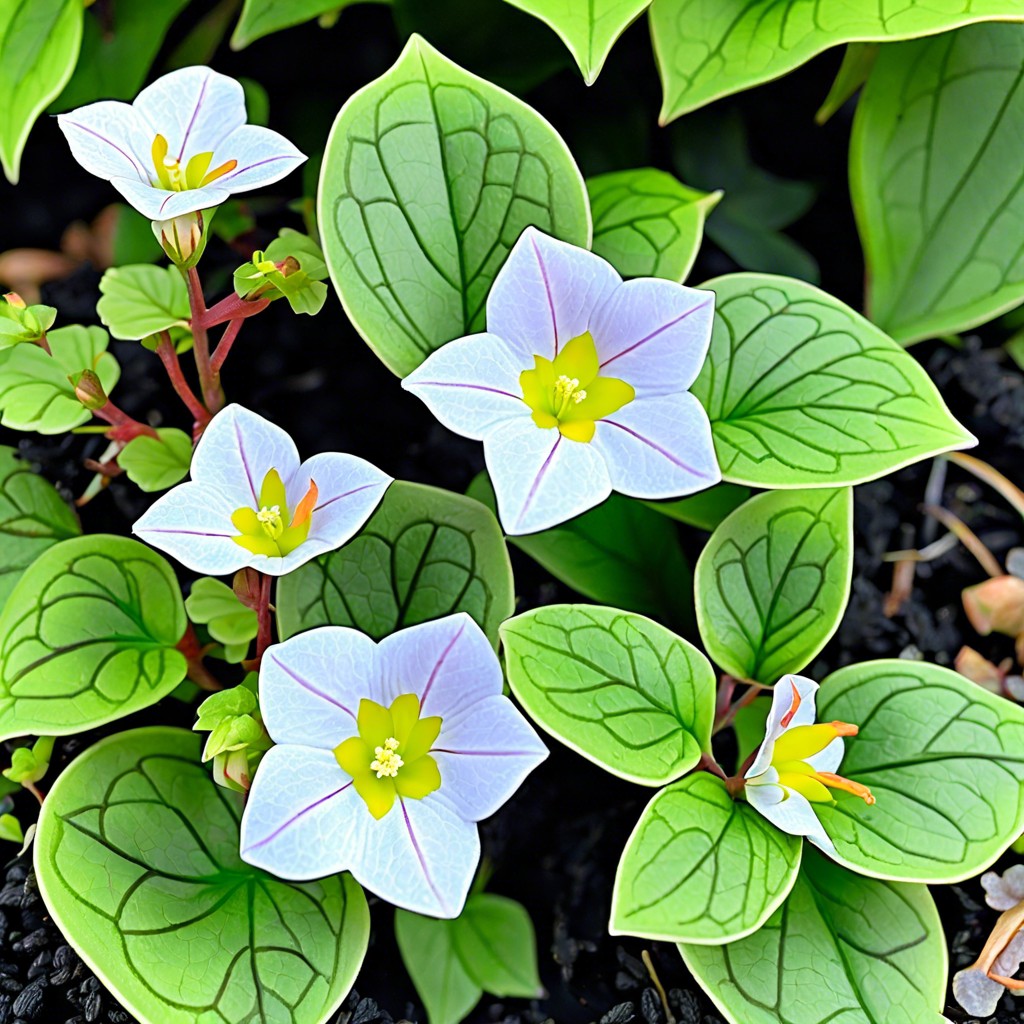
This plant, also known as chameleon plant or fish mint, has heart-shaped leaves with splashes of red, pink, yellow and green. It thrives in moist soil and partial shade but can tolerate full sun if the soil stays consistently damp.
One thing to keep in mind when planting Houttuynia Cordata is its tendency to spread quickly through underground rhizomes. To prevent it from taking over your entire garden bed, consider planting it in containers or using barriers around the edges of where you want it contained.
Despite its invasive tendencies, Houttuynia Cordata has many benefits for your outdoor space beyond just adding visual interest. Its leaves have been used for medicinal purposes such as treating respiratory infections and reducing inflammation.
Perennial Peanut
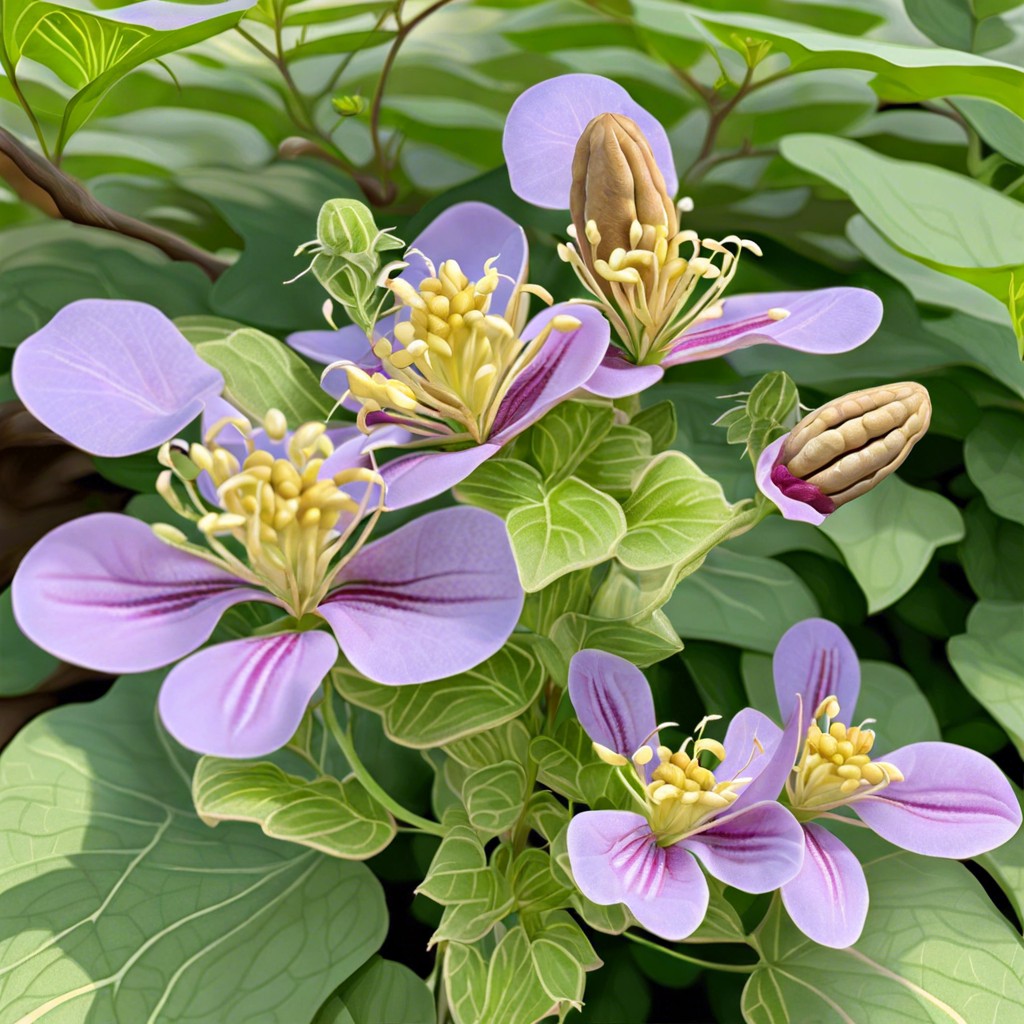
This low-growing, perennial plant produces yellow flowers in the summer and has a dense root system that helps prevent soil erosion. It’s also drought-tolerant, making it an excellent choice for areas with limited water resources.
One of the best things about Perennial Peanut is its ability to fix nitrogen in the soil. This means that it takes nitrogen from the air and converts it into a form that plants can use as fertilizer.
As a result, you won’t need to apply as much synthetic fertilizer or other chemicals to your garden.
Another benefit of Perennial Peanut is its versatility – it can be used as both ground cover and livestock feed! In fact, this plant was originally introduced from South America for use as animal feed due to its high protein content.
When planting Perennial Peanut, make sure you choose an area with well-draining soil and full sun exposure. Once established, this hardy plant requires little maintenance beyond occasional watering during dry spells.
Ophiopogon Japonicus

This evergreen perennial has long, narrow leaves that grow in clumps and produce small spikes of lavender flowers in the summer. It’s an excellent choice for borders or edging around trees and shrubs.
Mondo grass prefers partial shade but can tolerate full sun with adequate moisture. It’s drought-tolerant once established but benefits from regular watering during dry spells.
Mondo grass spreads slowly by underground rhizomes, making it easy to control.
One thing to keep in mind when planting mondo grass is that it requires well-draining soil; otherwise, root rot may occur. Adding organic matter such as compost or peat moss can improve drainage if your soil tends to be heavy or clay-like.
Euonymus Fortunei
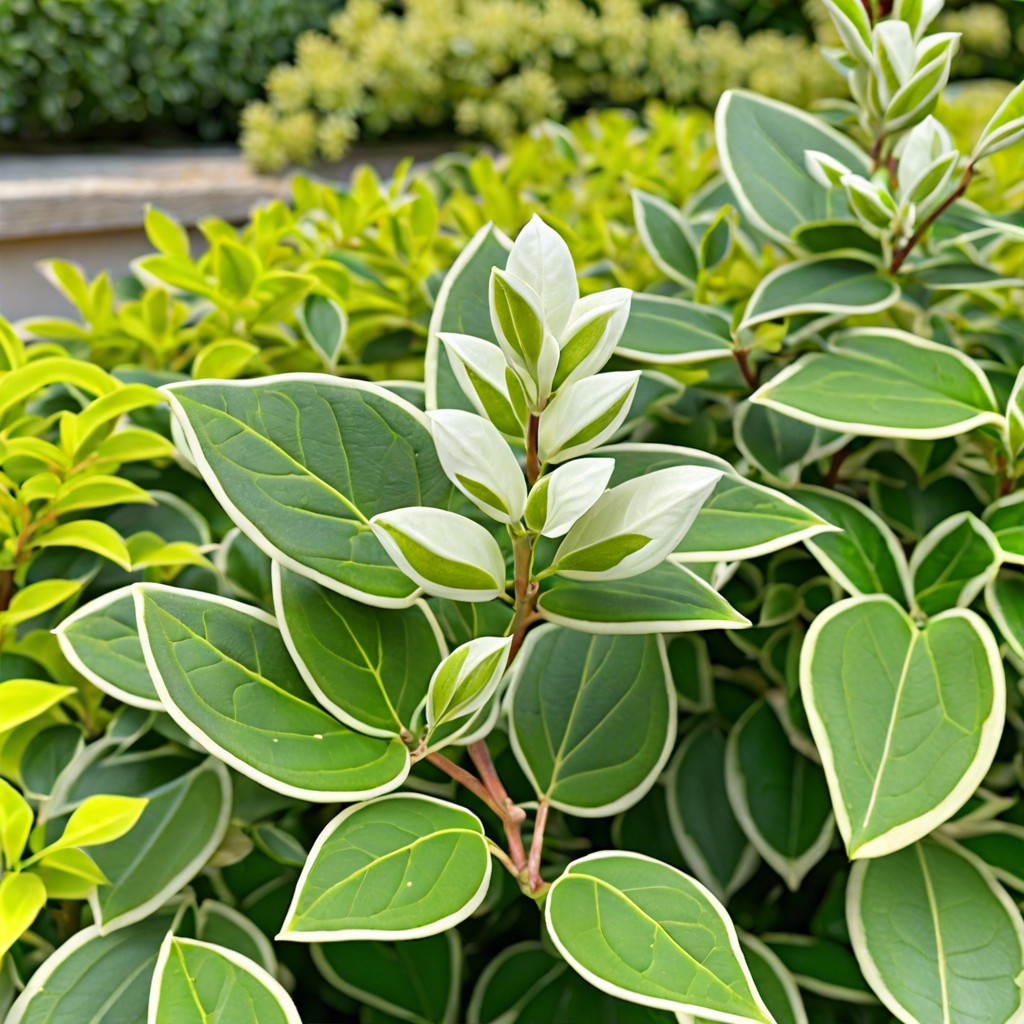
This evergreen plant features glossy green leaves that turn purple in the fall and produces small white flowers in the summer. It’s an excellent choice for areas with poor soil or limited sunlight since it can tolerate both drought and shade.
One of the benefits of Euonymus Fortunei is its ability to climb walls or other vertical surfaces, making it a great option for adding texture to your landscape design. It’s also easy to propagate by stem cuttings if you want more plants without having to spend extra money.
When planting Euonymus Fortunei, make sure you choose a well-draining location with partial shade or full sun exposure. The plant prefers slightly acidic soil but will adapt well to most types of soil as long as they are not waterlogged.
Maintenance-wise, this ground cover requires little attention once established but may benefit from occasional pruning during late spring or early summer if needed.
Benefits of Shade-Loving Ground Covers

These plants thrive in shady conditions and can add color and texture to your landscape without requiring too much maintenance. One of the biggest benefits of shade-loving ground covers is that they help prevent soil erosion, which can be a problem on sloped or hilly terrain.
They also provide insulation for the soil, helping to keep it cool during hot summer months.
Another advantage of using shade-loving ground covers is that they require less water than traditional grass lawns, making them an eco-friendly choice for homeowners looking to conserve water resources. Many varieties are low-growing and spread quickly over large areas, providing natural weed control while reducing the need for chemical herbicides.
When selecting shade-loving ground cover plants as alternatives to pachysandra or other common landscaping options like turfgrass or mulch beds; consider factors such as plant height at maturity (to avoid overcrowding), growth rate (for quick coverage), bloom time (for seasonal interest) and overall hardiness against pests/diseases prevalent in your area.
Environmental Considerations
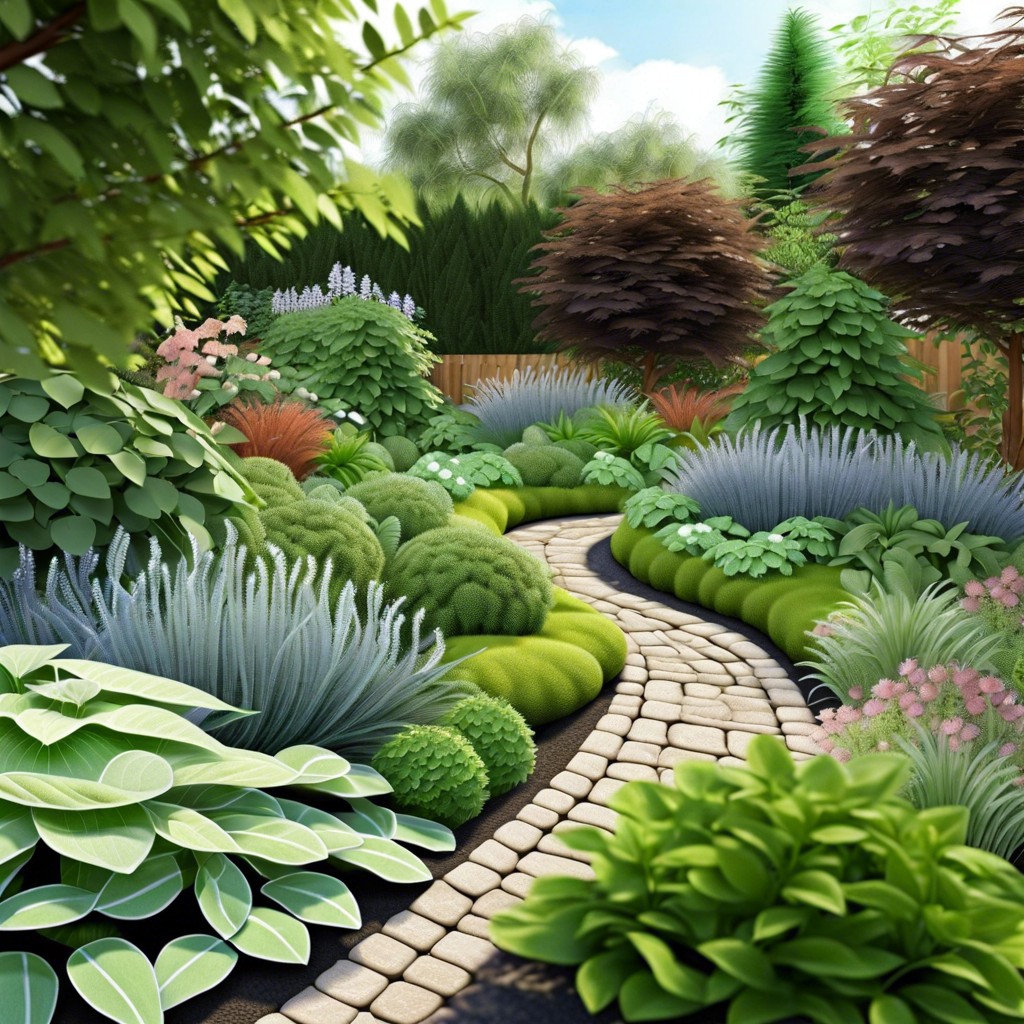
Some ground covers can be invasive and harm local ecosystems if not properly contained. Others may require more water or fertilizer than is sustainable for your area.
One way to ensure that you’re making an environmentally conscious choice is by selecting native plants whenever possible. Native species are adapted to the climate and soil conditions of your region, which means they’ll require less maintenance overall.
Another consideration is whether a plant will attract beneficial insects like bees and butterflies or repel pests like mosquitoes. Choosing plants that support local wildlife can help create a healthy ecosystem in your yard while also adding beauty.
Consider the impact of any chemicals used on your chosen ground cover plant on both human health and the environment as well as how much water it requires for growth.
Planting and Maintenance Tips
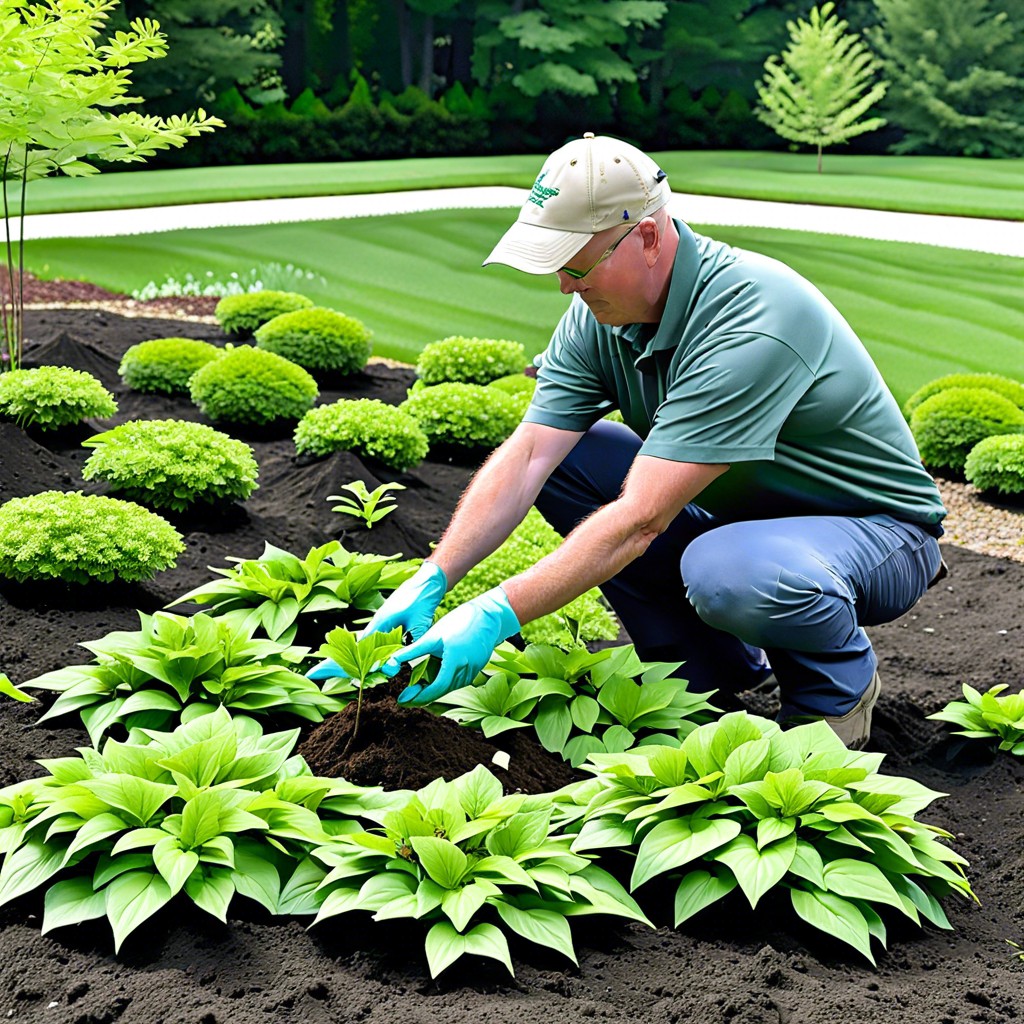
Here are some tips to help ensure your new ground cover thrives:
1. Prepare the soil: Before planting, make sure the soil is well-draining and free of weeds.
2. Planting depth: Be sure not to plant too deep or too shallow – follow instructions on seed packets or nursery tags.
3. Watering: Keep newly planted ground covers moist until they become established; then water as needed based on rainfall and temperature.
4. Fertilizing: Most ground covers don’t require much fertilizer but a light application in spring can be beneficial.
- Pruning/Trimming: Regular trimming will keep most plants looking neat while also promoting healthy growth.
- Weed Control : Weeds can quickly overtake a young bed of any type of plants including Ground Covers so regular weeding is essential
Mixing Ground Cover Plants
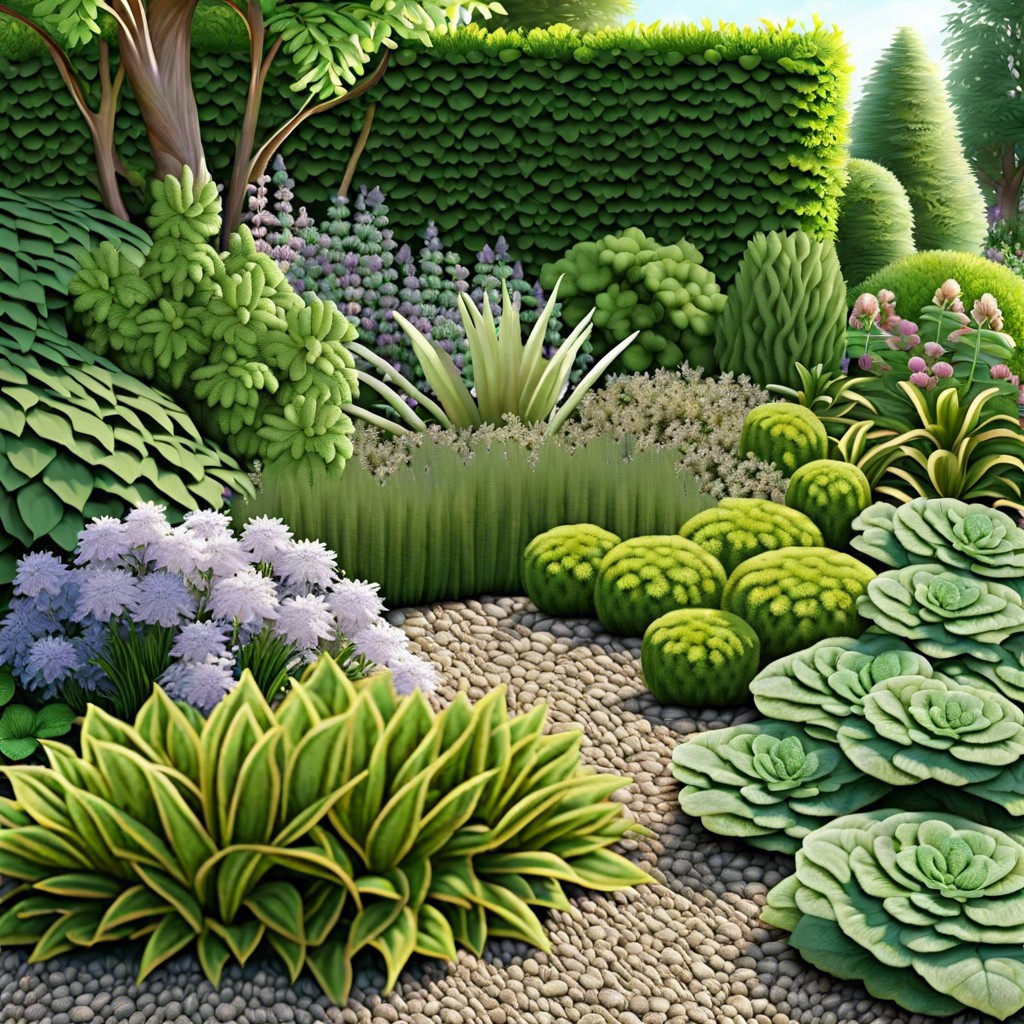
By combining various textures, colors, and heights, you can achieve a beautiful tapestry effect that will make your yard stand out from the rest.
When selecting ground covers to mix together, it’s important to consider their growth habits and maintenance requirements. Some plants may spread more aggressively than others or require more water or sunlight.
Be sure to choose varieties that are compatible with each other in terms of soil type and moisture levels.
To get started with mixing ground cover plants in your garden beds or borders, try pairing low-growing options like creeping thyme or Irish moss with taller options such as heuchera or ferns for added height variation. You could also experiment with contrasting foliage colors by planting ajuga reptans alongside lamb’s ear for an eye-catching display.
Remember that there are no hard-and-fast rules when it comes to mixing ground covers – feel free to get creative! With some careful planning and experimentation, you can create a stunning landscape design using these affordable alternatives to pachysandra.
FAQ
Which is better vinca or pachysandra?
Vinca is better than pachysandra as it spreads faster, allows bulb penetration and weed resistance, and is more sun-tolerant.
What are the cons of pachysandra?
The cons of pachysandra include its higher susceptibility to Volutella stem and leaf blight, which causes tan or brown blotches on leaves and stem cankers leading to dying stems.
What is the fastest growing ground cover for shade?
The fastest growing ground cover for shade is Yellow Archangel, which can grow up to 1 foot tall and 2 feet wide, adding a splash of yellow to the landscape.
What is the difference between Allegheny spurge and Japanese pachysandra?
The difference between Allegheny spurge and Japanese pachysandra is that Allegheny spurge leaves are softer and become mottled with white after blooming, while Japanese spurge leaves are stiff and glossy.
How do native ground cover plants compare to pachysandra in terms of environmental benefits and maintenance requirements?
Native ground cover plants generally require less maintenance and offer more environmental benefits compared to pachysandra.
What are the most drought-tolerant alternatives to pachysandra for ground cover?
Some of the most drought-tolerant alternatives to pachysandra for ground cover include creeping juniper, vinca minor, drought-tolerant sedums, and spotted deadnettle.
How can varying ground cover types, such as pachysandra and its alternatives, affect soil health and overall landscaping aesthetics?
Varying ground cover types, such as pachysandra and its alternatives, can affect soil health and overall landscaping aesthetics by providing diverse habitats, supporting distinct microorganisms, and offering unique visual elements.
Recap
